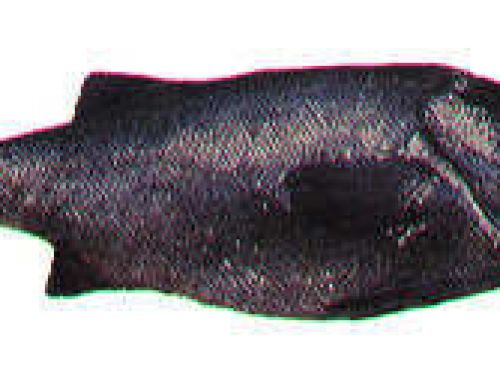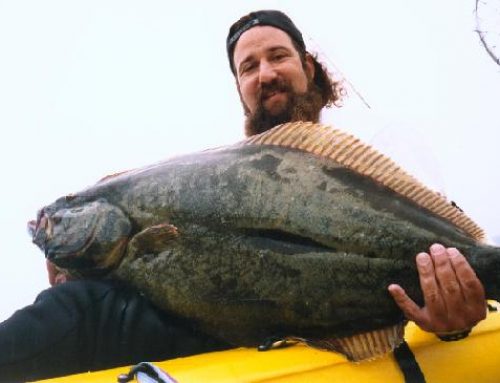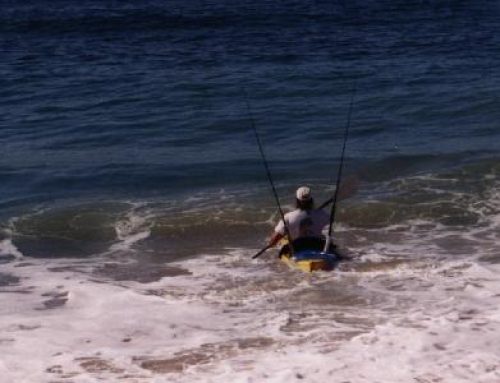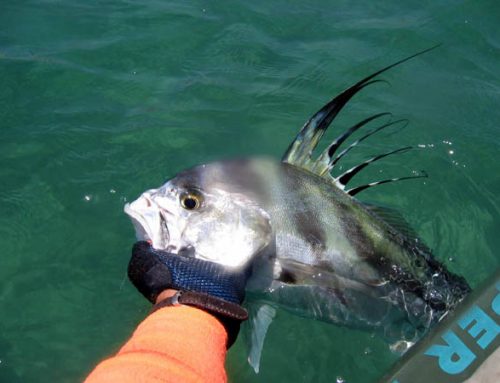To me, the dream inshore sport fishery would be one where the fishing grounds were easily accessible, could be fished year-round, and would produce more fishing action than surf fishing or party boating. Fishing would be inexpensive, and most importantly, would allow me to go fishing as easily as others go to the gym or play golf! As coastal dwellers we don’t need to invest in an expensive boat or be a slave to launch ramps, private landings, or charters to get out often and have productive fishing. Several years ago, after experimenting with various inflatables and beach launches, on a hunch, I picked up a cheap, used plastic kayak and paddle. After packing a small box with tackle, I grabbed a short rod with a Penn Squidder, and headed for the beach. That day, 15 minutes after launching, I caught and released a respectable calico bass that hit while I was paddling. Five minutes later, a 20 pound halibut gobbled a brown rubber twin tail that had been dropped at the edge of the kelp.
A light shined from the heavens and suddenly after 25 years of hit-and-miss fishing I realized that every body of water, from coast to coast, was open and available to fish anytime I want to put in.
In the time since I purchased that first kayak, I’ve caught more bass, trout, barracuda, and bonito, white sea bass, great sea bass, and a menagerie of other fish, rays, and sharks, than I had ever caught fishing on private boats, party boats, and the rest. All on my kayak. Consequently, I’m in better physical shape than when I started. Enough of my testimony, let’s get on the water. The following article is designed to get the new kayak fishermen from the sand to the fish in coastal conditions.
WHAT YOU NEED
- – Good Weather – Calm seas and small surf is the best way to perfect your skills.
- – Kayak – This is a plastic kayak sport. The models with the cockpit molded into the top are best. There are several on the market and used ones can be picked up fairly inexpensively. I recommend a kayak with at least one large hatch, although hatchless models can be customized and usually cost considerably less.
- – Paddle – Don’t go crazy. A simple two-piece big-bladed carbon paddle will suit your needs for a long time.
- – Personal Floatation Device – Safety First!
- – Gear – Start with a medium action 6 – 6 1/2 ‘ spinning rig or conventional outfit, whatever you’re most comfortable with. Keep it inexpensive to start. You’ll grow into your gear. Don’t forget a net, this is required by Fish and Game in almost every state.
- – Wetsuit and Booties – These are optional, but remember the fishing season is year-round. Even in winter, most days turn out to be T-shirt days, so I just peel my suit down to the waist and put on a T-shirt.
- – Dry Bags – One small bag for the reels. One medium for T-shirt, sweatshirt, tackle and lunch. I keep an extra, small bag, for personal stuff like sunguard, glasses, tide charts, etc.
WHAT YOU NEED TO DO – LAUNCHING & LANDING For beginners, the lakes, kelp forests, sand flats, rock piles and jetties is where you learn to catch fish on your kayak. Load your boat appropriately, stowing what you can, tying down the rest. For coastal launches, after you’ve brought your boat to the waters edge, sit and watch the sets of waves for 10 or 15 minutes. What you’re looking for is your “window”. That moment between sets when you put your boat in a few feet of water, sit down, and paddle like hell for the outside of the surf line. With any surf at all your “window of opportunity” can be as long as minutes to as short as 15 seconds. A good launch under most conditions takes only 5 to 20 seconds.
The surf zone is not to be taken for granted. This is where disasters can happen. Be aware of swell direction and size, currents, and rocks in the water. The more you launch and land your kayak, the better you get. Lots of practice should go into launching & landing.
When landing, after your gear is packed and secured, sit behind the surf zone awhile and again read the sets. It’s safest to paddle the back of small waves during the lull in sets. Once you’re in close, paddle hard so waves don’t catch you from behind, then step out and bring your kayak up above the water line.
FISHING
Once you’ve gotten past the surf zone, paddle to a good size kelp area. Get the feel of your boat. Move around your kayak and get comfortable. Open cockpit kayaks are extremely stable, unlike their white-water counterparts, and capsizing is pretty difficult once you’re out of the surf. Check the drift and current. Kelp stringers and plants are the best indicator for current direction. Find an edge to the kelp and tie off so that the current pulls you away from the canopy, leaving plenty of open area to fish. Watch for bait fish, birds and other activity in the water.
To set up for fishing I like to keep it as simple as possible to get the best results. I like 15 lb. test, an assortment of rubber in lime green, brown and oil colors with 1/2 to 1 1/2 oz. leadheads. Add a few pieces of iron like, UFO’s and Krokodiles in the mackerel patterns, chrome and blue, and lastly a Rapala anchovy to troll while paddling over any distance. This pretty much makes up my basic tackle.
To fish the kelp while tied on, work the open water first with big casts and various retrieves. Use all of your plastic and metal lures to see what produces a bite. Different days and conditions require different lures. If the fish fail to respond, start working the edge of the kelp. If a bite doesn’t occur after 15 minutes or so, make a move, taking note of the current. When you pick a new area to tie off to, work the new area just like the first. If you’re out there working the outer kelp and not getting bites by your fourth move, it’s time for some good old fashioned “Pot-holing”,fishing through the top of the kelp. “The canopy” can produce very, very big kelp bass, (at all levels) and sheephead at the bottom. I tend to drop my rubber baits down small openings rather than large pot-holes, depending upon the conditions.
If you know you’re over a true “canopy” and your bait goes down 3-10 feet and stops dead, set the hook hard and mind your drag, firm, but not tight. I’ve landed monster calicos this way. The fish I tend to hook up most in and around the kelp forests are of course the kelp bass, barracuda, white sea bass, halibut and rock fishes.
Another way to locate good fishing is by observing where the party boats make their inshore stops. Like most saltwater fisherman, I’ve spent a good part of my life fishing on 1/2 & 3/4 day local trips. These Skippers have great experience and know the best spots within their range. One thing I think we, as customers on party boats, take for granted is the expertise of most of the local skippers. They make stops on areas that have produced in the past, have good potential, and may be holding fish at that particular moment. When a bite doesn’t come on, it’s more a reflection on our fishery, than a sign of a bad captain.
When fishing near the party boats, I stay at least a few hundred yards away from them for a few reasons. First, big boats with lots of passengers need lots of room. Always pass on the bow, even if it means extra paddling, and never disturb the stern area of a fishing boat, no matter how harmless your intrusion may seem. Secondly, I like to position my kayak parallel to the big boats. When I see the white seabass, barracuda, and bonita coming over the rail, it’s only a matter of time until the school hits me and I start hooking up. In the meantime, work your baits furiously until you get bit. When I run up and down the coast to fish new areas, sometimes I’ll take a morning 1/2 day trip with the local landing. This allows me to get familiar with the coast, see what baits are catching fish, and pump the crew and passengers for as much information as possible. Getting in at 12 or 1 o’clock in the afternoon gives me time to find a place to put in and fish the afternoon on my kayak.
The calico bass is an integral game fish found in and around the kelp forests. It is also the most sought after fish by beginning kayak fishermen (and women) while building skills. Since we get so much time on the water in our kayaks, we have the potential to seriously impact our favorite fishing grounds, by taking too many fish. If you take calico and barred kelp bass, keep the 12 and 13 inchers and leave the large fish to reproduce. In the last few years I’ve always had enough halibut, white seabass, rockfish, etc. in the freezer, so there has been no need for kelp bass on the table. I like to think that my grandchildren will be catching “hawgs” and “bulls” that I release now. I know they will be fishing the same areas.
ACCESSORIZING YOUR KAYAK
Accessorizing your boat is inexpensive and furthers your fishing capabilities. For experienced sea kayakers, the use of electronics, seats, anchors, bait tanks, etc. gets you out of the kelp forests and off the sand flats, expanding your potential for excellent fishing all year.
A few things I recommend from the start are: 1) – Paddle Clips – These serve as fishing rod holders when launching and landing, then conveniently stow your paddle while fishing. Paddle clips are easily attached with blind rivets
2) – Rod Holders – There seem to be as many rod holders as fishing reels on the market. They are expensive and perform poorly on fishing kayaks. The SPIKESTRIKE™ Rod Holder, developed and tested for kayak fishing, is the best accessory available I like at least one holder on each side of the deck, within arms reach, behind the seat.
3) – Velcro! Velcro! Velcro! – When I first started out, everything I secured on my deck, from nets to dry bags, got stripped with adhesive Velcro. It not only adds to the security of your deck items, but also keeps your load from shifting, which makes a big difference in how your boat feels and performs.
4) – Surface Anchors – Surface Anchors are heavy duty elastic tethers, very much like a short paddle leash. They are used for anchoring to surface structure (kelp, buoys, and flotsam), deep anchoring, and lashing boats together, at the same time REDUCING SHOCK FROM SWELL. The Surface Anchor is a integral accessory and adds to the ease and productivity of kayak fishing. One Surface Anchor should be mounted on each side of the seat, while extras can be added to anchor riggings and lanyards.
A WORD ON SAFETY
I remember a few days in my life, sitting on the beach, when the ocean was calm as a lake. Within minutes, the wind came up and conditions changed. Boats scrambled for port and lifeguards picked people out of the water. These are dangerous conditions I’ve never encountered while on the water in my kayak. But I know this fast change in weather can happen without warning, and, with as much time as I spend out there, I expect to see that day. When I do, it will be a fast, hard paddle to the closest, safest stretch of beach.
Other situations that require extra caution are wind, fog, and other boats. WIND – Although wind will usually blow you off the water before it becomes a problem, offshore winds are tricky and can potentially blow you out to sea. Paddling into the wind is the only time I feather my paddle. This is a paddling technique that all sea kayakers should learn and practice. Although I like to fish mild offshore wind conditions because the breeze flattens out the ocean’s surface, these are days best spent tied to the kelp. FOG – When the fog is on the water, fish another day. I always stress that you have to be alert 100% of the time on your kayak. More than a few times I’ve looked up, lost in a daze of tranquillity, to see a mountain high wall of fog five minutes off my bow. This is a day ending condition. Two pieces of safety equipment that can be helpful in fog are a compass and a whistle. When dense fog does set in, your ears become your eyes! Make a safe landing!
OTHER BOATS – Visibility, size of swell, and boat traffic are all safety considerations when you fish from a kayak. Being seen by other boats is of obvious importance. For this reason, when picking out a new kayak, I prefer white or bright colors. Your rods in their holders make you much bigger in the water. None the less, if you paddle and fish high traffic areas or in a big swell, a 6 x 12″ vinyl flag can be attached to the tip of your longest rod with Velcro tabs to make you more visible.
THE EASE OF KAYAK FISHING
I started fishing the California inshore in 1964 at the age of 5. I’ve fished from the Mexican Border to Santa Cruz since then. What impresses me most about fishing from my kayak is the ease of fishing. From leaving home, until my return, it is the fastest and easiest way to fish the coast. I pick the day, the time, and the waters to fish. I’ve cut out the middleman, (private landings) eliminated the expense, (my own boat, landing fees, etc.) and get more time actually fishing than driving to landings and motoring to fishing spots. With the exception of boat, paddle, and rods, everything I need for a days fishing packs into a large plastic tub and a sports duffel bag. The tub is also nice at the end of the day for wet garments and towels.
The bottom line is that fishing from my kayak has allowed me to go from fishing 20 days on a good year, to fishing over 100 days every year. All this time on the water with, a fraction of the “non-productive” motoring time, more trophy size fish, and an understanding and anticipation of the coastal fishery and its environment that I never knew possible. Let me add that after your initial outlay for boat, paddle, and gear, expenses can be kept to under $10 for a days fishing!
In closing, I must acknowledge my faithful fishing partner. I am deeply indebted to my cousin, Howard Rose, aboard the “Giant Squid” for the hundreds of hours we’ve spent together fishing, learning, and discovering our coastal fishery. Although “solo” kayak fishing is a great sport, “partner” kayak fishing can double the catch as well as the experience. I would also like to thank Peter Barana, Senior Editor at Pacific Fisherman magazine, for giving me the opportunity to reach so many anglers and hopefully give them an alternative to fishing the”conventional” way. Good Fishing!
A NOTE ON BAIT
Frozen squid is an essential part of my “pack”. (my term for all my kayak fishing gear) When action is slow and I’ve run out of techniques, turning to the squid, whole or strips on jigs, has often produced bites, often enough that I don’t leave home without it!





Leave A Comment
You must be logged in to post a comment.